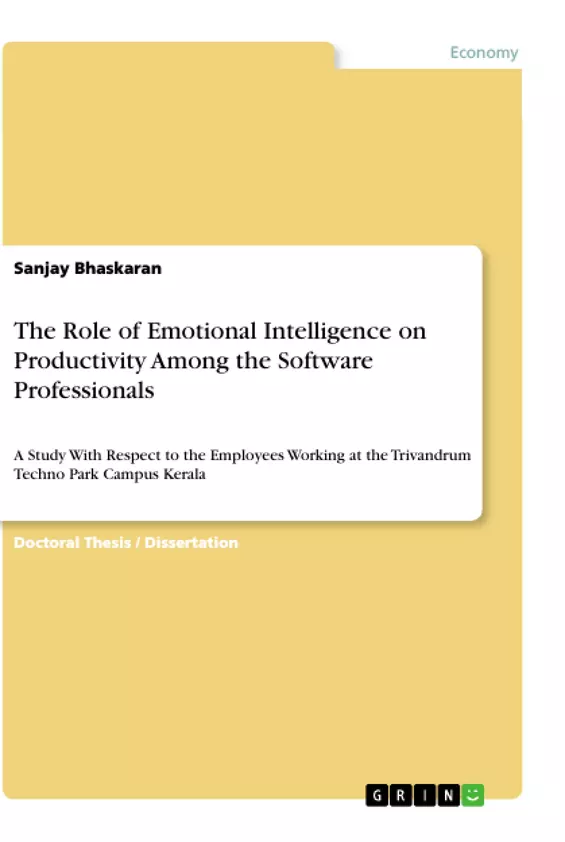The main goal of this dissertation is carrying out the research on the role of emotional intelligence on productivity among the software professionals working at the Thiruvananthapuram Techno park campus, Kerala.
Emotional Intelligence plays an important role in domains such as academic performance, job performance, leadership, trust, work-family conflict and stress. Even though many studies including cross-cultural differences are conducted among German (individualistic culture) versus Indian (collectivistic culture) and managerial perspectives on EI differences between India and the United States, no productivity related studies are attempted which covered the knowledge workers. Thus it became pertinent to find out the relationship between emotional intelligence and productivity of Software Professionals of Trivandrum Technopark, Kerala, India.
The most valuable asset of a 21st century institution (whether business or non-business) will be its knowledge workers and their productivity. Since knowledge workers have a greater impact in the economy‘s performance, they are perceived as an important area of opportunity and are starting to be included in organizational strategic plans to improve productivity. Increasing the productivity of knowledge workers provides a prospect for increasing profits by improving the overall process or product instead of simply eliminating costs. In the process of improving productivity, a factor called Emotional Intelligence (EI), a multi-dimensional construct, which includes a precise understanding of the emotion in self and emotional state of others, found to play a critical role.
Inhaltsverzeichnis (Table of Contents)
- INTRODUCTION AND DESIGN OF THE RESEARCH
- REVIEW OF EXISTING LITERATURE
- EMOTIONAL INTELLIGENCE OVERVIEW
- PROFILE OF SOFTWARE PROFESSIONALS WORKING IN TRIVANDRUM TECHNOPARK CAMPUS, KERALA
- Age of the Software Professionals Working in Trivandrum Technopark Campus, Kerala
- Gender of the Software Professionals Working in Trivandrum Technopark Campus, Kerala
- Marital Status of the Software Professionals Working in Trivandrum Technopark Campus, Kerala
- Type of family of the Software Professionals Working in Trivandrum Technopark Campus, Kerala
- Education of the Software Professionals Working in Trivandrum Technopark Campus, Kerala
- Monthly Income of the Software Professionals Working in Trivandrum Technopark Campus, Kerala
- Years of Experience of Software Professionals Working in Trivandrum Technopark Campus, Kerala
- Reason for professional choice of Software Professionals Working in Trivandrum Technopark Campus, Kerala
- Physical Health of Software Professionals Working in Trivandrum Technopark Campus, Kerala
- Mental Health of Software Professionals Working in Trivandrum Technopark Campus, Kerala
- Comparison of Physical and Mental health of the Software Professionals Working in Trivandrum Technopark Campus, Kerala.
- Interference of health conditions on Software Professionals Working in Trivandrum Technopark Campus, Kerala
- Concentration at Work of Software Professionals Working in Trivandrum Technopark Campus, Kerala
- Type of Company of Software Professionals Working in Trivandrum Technopark Campus, Kerala
- EMOTIONAL INTELLIGENCE AND PRODUCTIVITY OF SOFTWARE PROFESSIONALS
- IMPACT OF EMOTIONAL INTELLIGENCE ON PRODUCTIVITY
Zielsetzung und Themenschwerpunkte (Objectives and Key Themes)
This research aims to investigate the relationship between emotional intelligence and productivity among software professionals working at the Trivandrum Technopark Campus in Kerala, India. The study focuses on understanding how emotional intelligence contributes to their job performance and overall productivity.
- The role of emotional intelligence in the software development industry.
- The impact of emotional intelligence on productivity in software professionals.
- The relationship between emotional intelligence and various aspects of professional life, including job satisfaction, motivation, and stress management.
- The factors influencing the development and application of emotional intelligence among software professionals.
- The potential benefits of enhancing emotional intelligence for improving productivity in the software development field.
Zusammenfassung der Kapitel (Chapter Summaries)
The introduction of the thesis lays the groundwork for the research, outlining the context, significance, and objectives of the study. It provides a comprehensive overview of emotional intelligence, its dimensions, and its relevance to the field of software development. The chapter also delves into the design of the research, including the methodology, data collection methods, and the population under investigation.
The review of existing literature chapter explores previous research on emotional intelligence and its impact on various aspects of organizational behavior and productivity. This chapter provides a comprehensive review of existing research and establishes the theoretical framework for the study. The study delves into the concept of emotional intelligence and its evolution, examining different models and definitions proposed by researchers.
This chapter focuses on the demographics and profile of software professionals working at the Trivandrum Technopark Campus, Kerala. It delves into their age, gender, marital status, family background, education, income, work experience, health conditions, and other relevant characteristics. The chapter aims to understand the specific context and characteristics of the software professional population under investigation.
The chapter explores the relationship between emotional intelligence and productivity among software professionals. It investigates how different aspects of emotional intelligence, such as self-awareness, self-regulation, motivation, empathy, and social skills, contribute to their job performance and productivity. The chapter analyzes the data collected from the study and draws conclusions about the impact of emotional intelligence on various aspects of productivity, including task completion, efficiency, and overall job satisfaction.
Schlüsselwörter (Keywords)
The primary keywords and focus topics of this thesis include emotional intelligence, productivity, software professionals, Trivandrum Technopark Campus, job performance, self-awareness, self-regulation, motivation, empathy, social skills, and workplace stress.
- Citation du texte
- Sanjay Bhaskaran (Auteur), 2018, The Role of Emotional Intelligence on Productivity Among the Software Professionals, Munich, GRIN Verlag, https://www.grin.com/document/505432



